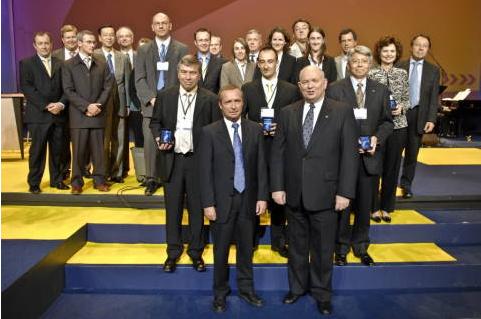D. ROUSSET
The "Construction, maintenance and operation of roads" prize, sponsored by Belgium, was awarded to: Tadashi Kuroiwa, Koichi Nishikawa, Ikuo Iwasaki, and Hikari Okuma from Japan, for an essay on the Development of Highway Bridge applying Ultra High Strength Fiber Reinforced Concrete"
This material results from a technology transfer of the "reactive powder concrete" which was invented and developed in France. Its properties in terms of durability and ductility captured the attention of Japan which already used it on several occasions for footbridges.
What was the motivation of the jury to award the prize to this project?
C. VAN ROOTEN
The jury wished to acknowledge here, an example of technology transfer for an application which up until now, has not been used for this purpose.
The remarkable properties of the fibre concrete make it possible for an increase in the length of the working life and thus a reduction in the cost of these works over their lifespan. As this example demonstrates, it is important to undertake research and experiments in this field.
D. ROUSSET
"The Sustainable development" prize, sponsored by Switzerland, was awarded to: François Olard and Claude Le Noan from France, for their work on Low Energy Asphalts.
Compared to the traditional bitumen coatings, this manufacturing process makes it possible to reduce the temperature when laying, from 180˚C to 140˚C. Why does this reduction in temperature of 40˚C deserve this award?
C. VAN ROOTEN
This reduction in temperature allows at the time of production, a reduction in the consumption of energy (of 50%) and thus, a reduction in CO2 emissions. On the construction site, this also improves the working conditions considerably.
Therefore, the jury considered that this was an innovative project which reflects principles of sustainable development and which is representative of the direction the road sector can take.
D. ROUSSET
"The Communication prize", sponsored by Romania, was awarded to Danada McMurty from the U. S. A. for her essay entitled "Passing the Baton: Communication Techniques for Developing Tomorrow's Transportation Workforce".
This essay demonstrated the results which can be obtained through the application of communication techniques in the field of human resources, in relation to target audiences and to communicate messages in a manner which is able to bring about changes of behaviour with positive results.
This experimentation was carried out within the Department of Transport of Mississippi but also towards the young people who will be the recruits of tomorrow, from five years of age until they reach university.
C. VAN ROOTEN
What interested the jury was the dynamic approach of the questions regarding education and training at a time when many administrations wonder about their renewal of personnel, how to have sufficient human resources and how to organise the process of knowledge transfer.
D. ROUSSET
The special prize for "Young Professionals" , sponsored by France and Canada-Québec was awarded to Alan Dunford,Jill Weekley, Ronit Tong and Clare Harmer from the United-Kingdom for their essay An Intelligent Journey to the Olympic Games 2012, A Documentary.
This paper is written as a fictional illustration demonstrating the potentialities of intelligent transport systems on the day of the opening of the Olympic Games of 2012. This documentary follows three people each using different modes of preferred transport - private car, public transport and bicycle - to attend the Olympic Games in London.
C. VAN ROOTEN
The jury really appreciated the freshness of the report which was written particularly well. In addition, this paper effectively highlights the contributions of new technologies in regards to safety, comfort and reliability of different modes of transport in the field of Intelligent Transport Systems which can, in the near future, contribute to bring environmental solutions to societies which require ever increasing mobility.
D. ROUSSET
"The Maurice Milne medal", sponsored by the United-Kingdom, goes to the best innovative idea. It was awarded to Michel Ballié and Thierry Delcroix from France, for their work on an Innovative plant-based binder for road mixes and pavement surfacings.
This plant-based binder is developed initially from raw vegetables. As a result of this, one can manufacture bituminous mix with a temperature of approximately 110˚C. Already, we have seen that there is environmental interest in this reduction of temperature. These plant based binders are thus presented as possible substitutes for bitumen. Could grapeseed oil be a possible replacement for petrol, is it possible?
C. VAN ROOTEN
Yes. It demonstrates real innovation, from which the various aspects were controlled by the developers. Of course, only the future will reveal if the evolution of economic conditions, the costs of the performances and also the availability of the petroleum products and plants will allow wide scale utilisation of this type of binders. But the jury would like to acknowledge the capacity of anticipation and innovation in the road industry.
